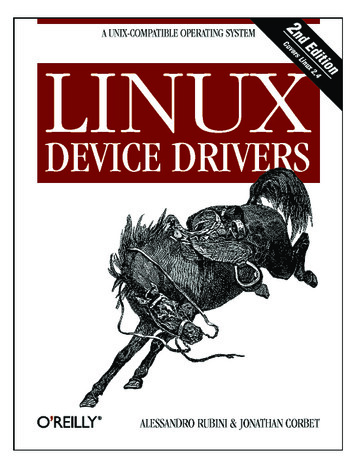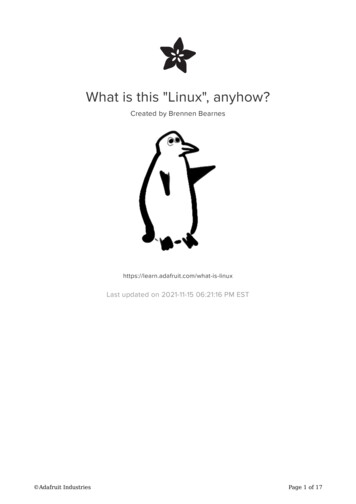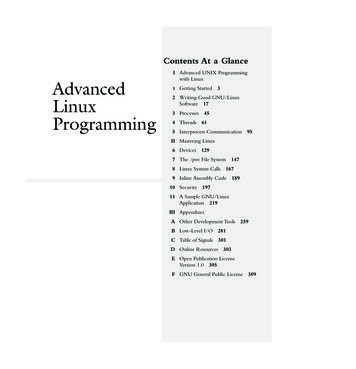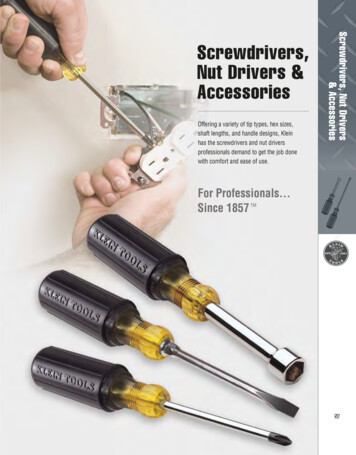
Transcription
PREFACEThis is, on the surface, a book about writing device drivers for the Linux system.That is a worthy goal, of course; the flow of new hardware products is not likelyto slow down anytime soon, and somebody is going to have to make all thosenew gadgets work with Linux. But this book is also about how the Linux kernelworks and how to adapt its workings to your needs or interests. Linux is an opensystem; with this book, we hope, it will be more open and accessible to a largercommunity of developers.Much has changed with Linux since the first edition of this book came out. Linuxnow runs on many more processors and supports a much wider variety of hardware. Many of the internal programming interfaces have changed significantly.Thus, the second edition. This book covers the 2.4 kernel, with all of the new features that it provides, while still giving a look backward to earlier releases forthose who need to support them.We hope you’ll enjoy reading this book as much as we have enjoyed writing it.Alessandro’s IntroductionAs an electronic engineer and a do-it-yourself kind of person, I have alwaysenjoyed using the computer to control external hardware. Ever since the days ofmy father’s Apple IIe, I have been looking for another platform where I could connect my custom circuitry and write my own driver software. Unfortunately, the PCof the 1980s wasn’t powerful enough, at either the software or the hardware level:the internal design of the PC is much worse than that of the Apple II, and theavailable documentation has long been unsatisfying. But then Linux appeared, andI decided to give it a try by buying an expensive 386 motherboard and no proprietary software at all.xi22 June 2001 16:32
PrefaceAt the time, I was using Unix systems at the university and was greatly excited bythe smart operating system, in particular when supplemented by the even smarterutilities that the GNU project donates to the user base. Running the Linux kernelon my own PC motherboard has always been an interesting experience, and Icould even write my own device drivers and play with the soldering iron onceagain. I continue to tell people, “When I grow up, I wanna be a hacker,” andGNU/Linux is the perfect platform for such dreams. That said, I don’t know if Iwill ever grow up.As Linux matures, more and more people get interested in writing drivers for custom circuitry and for commercial devices. As Linus Torvalds noted, “We’re back tothe times when men were men and wrote their own device drivers.”Back in 1996, I was hacking with my own toy device drivers that let me play withsome loaned, donated, or even home-built hardware. I already had contributed afew pages to the Ker nel Hacker’s Guide, by Michael Johnson, and began writingkernel-related articles for Linux Journal, the magazine Michael founded anddirected. Michael put me in touch with Andy Oram at O’Reilly; he expressed aninterest in having me write a whole book about device drivers, and I accepted thistask, which kept me pretty busy for quite a lot of time.In 1999 it was clear I couldn’t find the energy to update the book by myself: myfamily had grown and I had enough programming work to keep busy producingexclusively GPL’d software. Besides, the kernel had grown bigger and supportedmore diverse platforms than it used to, and the API had turned more broad andmore mature. That’s when Jonathan offered to help: he had just the right skills andenthusiasm to start the update and to force me to stay on track with the schedule — which slipped quite a lot anyway. He’s been an invaluable mate in the process, which he pushed forward with good skills and dedication, definitely morethan I could put in. I really enjoyed working with him, both on a technical andpersonal level.Jon’s IntroductionI first started actively playing with Linux early in 1994, when I convinced myemployer to buy me a laptop from a company called, then, Fintronic Systems.Having been a Unix user since the beginning of the 1980s, and having playedaround in the source since about then, I was immediately hooked. Even in 1994,Linux was a highly capable system, and the first truly free system that I had everbeen able to work with. I lost almost all my interest in working with proprietarysystems at that point.I didn’t ever really plan to get into writing about Linux, though. Instead, when Istarted talking with O’Reilly about helping with the second edition of this book, Ihad recently quit my job of 18 years to start a Linux consulting company. As a wayxii22 June 2001 16:32
Prefaceof attracting attention to ourselves, we launched a Linux news site, Linux WeeklyNews (http://lwn.net), which, among other things, covered kernel development. AsLinux exploded in popularity, the web site did too, and the consulting businesswas eventually forgotten.But my first interest has always been systems programming. In the early days, thatinterest took the form of “fixing” the original BSD Unix paging code (which has tohave been a horrible hack job) or making recalcitrant tape drives work on aVAX/VMS system (where source was available, if you didn’t mind the fact that itwas in assembly and Bliss, and came on microfiche only). As time passed, I got tohack drivers on systems with names like Alliant, Ardent, and Sun, before movinginto tasks such as deploying Linux as a real-time radar data collection system or, inthe process of writing this book, fixing the I/O request queue locking in the Linuxfloppy driver.So I welcomed the opportunity to work on this book for several reasons. As muchas anything, it was a chance to get deeply into the code and to help others with asimilar goal. Linux has always been intended to be fun as well as useful, and playing around with the kernel is one of the most fun parts of all—at least, for thosewith a certain warped sense of fun. Working with Alessandro has been a joy, and Imust thank him for trusting me to hack on his excellent text, being patient withme as I came up to speed and as I broke things, and for that jet-lagged bicycletour of Pavia. Writing this book has been a great time.Audience of This BookOn the technical side, this text should offer a hands-on approach to understandingthe kernel internals and some of the design choices made by the Linux developers. Although the main, official target of the book is teaching how to write devicedrivers, the material should give an interesting overview of the kernel implementation as well.Although real hackers can find all the necessary information in the official kernelsources, usually a written text can be helpful in developing programming skills.The text you are approaching is the result of hours of patient grepping throughthe kernel sources, and we hope the final result is worth the effort it took.This book should be an interesting source of information both for people whowant to experiment with their computer and for technical programmers who facethe need to deal with the inner levels of a Linux box. Note that “a Linux box” is awider concept than “a PC running Linux,” as many platforms are supported by ouroperating system, and kernel programming is by no means bound to a specificplatform. We hope this book will be useful as a starting point for people whowant to become kernel hackers but don’t know where to start.xiii22 June 2001 16:32
PrefaceThe Linux enthusiast should find in this book enough food for her mind to startplaying with the code base and should be able to join the group of developersthat is continuously working on new capabilities and performance enhancements.This book does not cover the Linux kernel in its entirety, of course, but Linuxdevice driver authors need to know how to work with many of the kernel’s subsystems. It thus makes a good introduction to kernel programming in general.Linux is still a work in progress, and there’s always a place for new programmersto jump into the game.If, on the other hand, you are just trying to write a device driver for your owndevice, and you don’t want to muck with the kernel internals, the text should bemodularized enough to fit your needs as well. If you don’t want to go deep intothe details, you can just skip the most technical sections and stick to the standardAPI used by device drivers to seamlessly integrate with the rest of the kernel.The main target of this book is writing kernel modules for version 2.4 of the Linuxkernel. A module is object code that can be loaded at runtime to add new functionality to a running kernel. Wherever possible, however, our sample code alsoruns on versions 2.2 and 2.0 of the kernel, and we point out where things havechanged along the way.Organization of the MaterialThe book introduces its topics in ascending order of complexity and is dividedinto two parts. The first part (Chapters 1 to 10) begins with the proper setup ofkernel modules and goes on to describe the various aspects of programming thatyou’ll need in order to write a full-featured driver for a char-oriented device. Everychapter covers a distinct problem and includes a “symbol table” at the end, whichcan be used as a reference during actual development.Throughout the first part of the book, the organization of the material movesroughly from the software-oriented concepts to the hardware-related ones. Thisorganization is meant to allow you to test the software on your own computer asfar as possible without the need to plug external hardware into the machine. Everychapter includes source code and points to sample drivers that you can run on anyLinux computer. In Chapter 8 and Chapter 9, however, we’ll ask you to connect aninch of wire to the parallel port in order to test out hardware handling, but thisrequirement should be manageable by everyone.The second half of the book describes block drivers and network interfaces andgoes deeper into more advanced topics. Many driver authors will not need thismaterial, but we encourage you to go on reading anyway. Much of the materialfound there is interesting as a view into how the Linux kernel works, even if youdo not need it for a specific project.xiv22 June 2001 16:32
PrefaceBackground InformationIn order to be able to use this book, you need to be confident with C programming. A little Unix expertise is needed as well, as we often refer to Unix commands and pipelines.At the hardware level, no previous expertise is required to understand the materialin this book, as long as the general concepts are clear in advance. The text isn’tbased on specific PC hardware, and we provide all the needed information whenwe do refer to specific hardware.Several free software tools are needed to build the kernel, and you often needspecific versions of these tools. Those that are too old can lack needed features,while those that are too new can occasionally generate broken kernels. Usually,the tools provided with any current distribution will work just fine. Tool versionrequirements vary from one kernel to the next; consult Documentation/Changes inthe source tree of the kernel you are using for exact requirements.Sources of Further InformationMost of the information we provide in this book is extracted directly from the kernel sources and related documentation. In particular, pay attention to the Documentation directory that is found in the kernel source tree. There is a wealth ofuseful information there, including documentation of an increasing part of the kernel API (in the DocBook subdirectory).There are a few interesting books out there that extensively cover related topics;they are listed in the bibliography.There is much useful information available on the Internet; the following is a sampling. Internet sites, of course, tend to be highly volatile while printed books arehard to update. Thus, this list should be regarded as being somewhat out of date.http://www.ker nel.orgftp://ftp.ker nel.orgThis site is the home of Linux kernel development. You’ll find the latest kernelrelease and related information. Note that the FTP site is mirrored throughoutthe world, so you’ll most likely find a mirror near you.http://www.linuxdoc.orgThe Linux Documentation Project carries a lot of interesting documents called“HOWTOs”; some of them are pretty technical and cover kernel-related topics.xv22 June 2001 16:32
Prefacehttp://www.linux-mag.com/depts/gear.htmlThe “Gearheads only” section from Linux Magazine often runs kernel-orientedarticles from well-known developers.http://www.linux.it/ker neldocsThis page contains many kernel-oriented magazine articles written by Alessandro.http://lwn.netAt the risk of seeming self-serving, we’ll point out this news site (edited byone of your authors) which, among other things, offers regular kernel development coverage.http://kt.zork.netKernel Traffic is a popular site that provides weekly summaries of discussionson the Linux kernel development mailing list.http://www.atnf.csir o.au/ rgooch/linux/docs/ker nel-newsflash.htmlThe Kernel Newsflash site is a clearinghouse for late-breaking kernel news. Inparticular, it concentrates on problems and incompatibilities in current kernelreleases; thus, it can be a good resource for people trying to figure out whythe latest development kernel broke their drivers.http://www.ker nelnotes.orgKernel Notes is a classic site with information on kernel releases, unofficialpatches, and more.http://www.ker nelnewbies.orgThis site is oriented toward new kernel developers. There is beginning information, an FAQ, and an associated IRC channel for those looking for immediate assistance.http://lksr.orgThe Linux Kernel Source Reference is a web interface to a CVS archive containing an incredible array of historical kernel releases. It can be especiallyuseful for finding out just when a particular change occurred.http://www.linux-mm.orgThis page is oriented toward Linux memory management development. It contains a fair amount of useful information and an exhaustive list of kernel-oriented web links.http://www.conecta.it/linuxThis Italian site is one of the places where a Linux enthusiast keeps updatedinformation about all the ongoing projects involving Linux. Maybe you alreadyknow an interesting site with HTTP links about Linux development; if not, thisone is a good starting point.xvi22 June 2001 16:32
PrefaceOnline Version and LicenseThe authors have chosen to make this book freely available under the GNU FreeDocumentation License, version 1.1.Full licensehttp://www.or html;HTMLhttp://www.or http://www.or l;PDFhttp://www.or .html.Conventions Used in This BookThe following is a list of the typographical conventions used in this book:ItalicConstant WidthConstant ItalicConstant BoldUsed for file and directory names, program and commandnames, command-line options, URLs, and new termsUsed in examples to show the contents of files or the output from commands, and in the text to indicate wordsthat appear in C code or other literal stringsUsed to indicate variable options, keywords, or text thatthe user is to replace with an actual valueUsed in examples to show commands or other text thatshould be typed literally by the userPay special attention to notes set apart from the text with the following icons:This is a tip. It contains useful supplementary information about thetopic at hand.This is a warning. It helps you solve and avoid annoying problems.xvii22 June 2001 16:32
PrefaceWe’d Like to Hear from YouWe have tested and verified the information in this book to the best of our ability,but you may find that features have changed (or even that we have made mistakes!). Please let us know about any errors you find, as well as your suggestionsfor future editions, by writing to:O’Reilly & Associates, Inc.101 Morris StreetSebastopol, CA 95472(800) 998-9938 (in the United States or Canada)(707) 829-0515 (international/local)(707) 829-0104 (fax)We have a web page for the book, where we list errata, examples, or any additional information. You can access this page at:http://www.or eilly.com/catalog/linuxdrive2To comment or ask technical questions about this book, send email to:bookquestions@or eilly.comFor more information about our books, conferences, software, Resource Centers,and the O’Reilly Network, see our web site at:http://www.or eilly.comAcknowledgmentsThis book, of course, was not written in a vacuum; we would like to thank themany people who have helped to make it possible.I (Alessandro) would like to thank the people that made this work possible. Firstof all, the incredible patience of Federica, who went as far as letting me review thefirst edition during our honeymoon, with a laptop in the tent. Giorgio and Giuliahave only been involved in the second edition of the book, and helped me stay intouch with reality by eating pages, pulling wires, and crying for due attention. Imust also thank all four grandparents, who came to the rescue when the deadlineswere tight and took over my fatherly duties for whole days, letting me concentrateon code and coffee. I still owe a big thanks to Michael Johnson, who made meenter the world of writing. Even though this was several years ago, he’s still theone that made the wheel spin; earlier, I had left the university to avoid writing articles instead of software. Being an independent consultant, I have no employerthat kindly allowed me to work on the book; on the other hand, I owe dueacknowledgment to Francesco Magenta and Rodolfo Giometti, who are helpingme as “dependent consultants.” Finally, I want to acknowledge the free-softwareauthors who actually taught me how to program without even knowing me; thisxviii22 June 2001 16:32
Prefaceincludes both kernel and user-space authors I enjoyed reading, but they are toomany to list.I (Jon) am greatly indebted to many people; first and foremost I wish to thank mywife, Laura, who put up with the great time demands of writing a book whilesimultaneously trying to make a “dotcom” business work. My children, Micheleand Giulia, have been a constant source of joy and inspiration. Numerous peopleon the linux-kernel list showed great patience in answering my questions and setting me straight on things. My colleagues at LWN.net have been most patient withmy distraction, and our readers’ support of the LWN kernel page has been outstanding. This edition probably would not have happened without the presence ofBoulder’s local community radio station (appropriately named KGNU), whichplays amazing music, and the Lake Eldora ski lodge, which allowed me to campout all day with a laptop during my kids’ ski lessons and served good coffee. Iowe gratitude to Evi Nemeth for first letting me play around in the early BSDsource on her VAX, to William Waite for really teaching me to program, and to RitCarbone of the National Center for Atmospheric Research (NCAR), who got mestarted on a long career where I learned almost everything else.We both wish to thank our editor, Andy Oram; this book is a vastly better productas a result of his efforts. And obviously we owe a lot to the smart people whopushed the free-software idea and still keep it running (that’s mainly Richard Stallman, but he’s definitely not alone).We have also been helped at the hardware level; we couldn’t study so many platforms without external help. We thank Intel for loaning an early IA-64 system, andRebel.com for donating a Netwinder (their ARM-based tiny computer). Prosa Labs,the former Linuxcare-Italia, loaned a pretty fat PowerPC system; NEC Electronicsdonated their interesting development system for the VR4181 processor — that’s apalmtop where we could put a GNU/Linux system on flash memory. Sun-Italialoaned both a SPARC and a SPARC64 system. All of those companies and thosesystems helped keep Alessandro busy in debugging portability issues and forcedhim to get one more room to fit his zoo of disparate silicon beasts.The first edition was technically reviewed by Alan Cox, Greg Hankins, Hans Lermen, Heiko Eissfeldt, and Miguel de Icaza (in alphabetic order by first name). Thetechnical reviewers for the second edition were Allan B. Cruse, Christian Morgner,Jake Edge, Jeff Garzik, Jens Axboe, Jerry Cooperstein, Jerome Peter Lynch, MichaelKerrisk, Paul Kinzelman, and Raph Levien. Together, these people have put a vastamount of effort into finding problems and pointing out possible improvements toour writing.Last but certainly not least, we thank the Linux developers for their relentlesswork. This includes both the kernel programmers and the user-space people, whooften get forgotten. In this book we chose never to call them by name in order toavoid being unfair to someone we might forget. We sometimes made an exceptionto this rule and called Linus by name; we hope he doesn’t mind, though.xix22 June 2001 16:32
CHAPTER ONEAN INTRODUCTION TODEVICE DRIVERSAs the popularity of the Linux system continues to grow, the interest in writingLinux device drivers steadily increases. Most of Linux is independent of the hardware it runs on, and most users can be (happily) unaware of hardware issues. But,for each piece of hardware supported by Linux, somebody somewhere has writtena driver to make it work with the system. Without device drivers, there is no functioning system.Device drivers take on a special role in the Linux kernel. They are distinct “blackboxes” that make a particular piece of hardware respond to a well-defined internalprogramming interface; they hide completely the details of how the device works.User activities are performed by means of a set of standardized calls that are independent of the specific driver; mapping those calls to device-specific operationsthat act on real hardware is then the role of the device driver. This programminginterface is such that drivers can be built separately from the rest of the kernel,and “plugged in” at runtime when needed. This modularity makes Linux driverseasy to write, to the point that there are now hundreds of them available.There are a number of reasons to be interested in the writing of Linux devicedrivers. The rate at which new hardware becomes available (and obsolete!) aloneguarantees that driver writers will be busy for the foreseeable future. Individualsmay need to know about drivers in order to gain access to a particular device thatis of interest to them. Hardware vendors, by making a Linux driver available fortheir products, can add the large and growing Linux user base to their potentialmarkets. And the open source nature of the Linux system means that if the driverwriter wishes, the source to a driver can be quickly disseminated to millions ofusers.122 June 2001 16:32
Chapter 1: An Introduction to Device DriversThis book will teach you how to write your own drivers and how to hack aroundin related parts of the kernel. We have taken a device-independent approach; theprogramming techniques and interfaces are presented, whenever possible, withoutbeing tied to any specific device. Each driver is different; as a driver writer, youwill need to understand your specific device well. But most of the principles andbasic techniques are the same for all drivers. This book cannot teach you aboutyour device, but it will give you a handle on the background you need to makeyour device work.As you learn to write drivers, you will find out a lot about the Linux kernel in general; this may help you understand how your machine works and why thingsaren’t always as fast as you expect or don’t do quite what you want. We’ll introduce new ideas gradually, starting off with very simple drivers and building uponthem; every new concept will be accompanied by sample code that doesn’t needspecial hardware to be tested.This chapter doesn’t actually get into writing code. However, we introduce somebackground concepts about the Linux kernel that you’ll be glad you know later,when we do launch into programming.The Role of the Device DriverAs a programmer, you will be able to make your own choices about your driver,choosing an acceptable trade-off between the programming time required and theflexibility of the result. Though it may appear strange to say that a driver is “flexible,” we like this word because it emphasizes that the role of a device driver isproviding mechanism, not policy.The distinction between mechanism and policy is one of the best ideas behind theUnix design. Most programming problems can indeed be split into two parts:“what capabilities are to be provided” (the mechanism) and “how those capabilities can be used” (the policy). If the two issues are addressed by different parts ofthe program, or even by different programs altogether, the software package ismuch easier to develop and to adapt to particular needs.For example, Unix management of the graphic display is split between the Xserver, which knows the hardware and offers a unified interface to user programs,and the window and session managers, which implement a particular policy without knowing anything about the hardware. People can use the same window manager on different hardware, and different users can run different configurations onthe same workstation. Even completely different desktop environments, such asKDE and GNOME, can coexist on the same system. Another example is the layered structure of TCP/IP networking: the operating system offers the socketabstraction, which implements no policy regarding the data to be transferred,while different servers are in charge of the services (and their associated policies).222 June 2001 16:32
The Role of the Device DriverMoreover, a server like ftpd provides the file transfer mechanism, while users canuse whatever client they prefer; both command-line and graphic clients exist, andanyone can write a new user interface to transfer files.Where drivers are concerned, the same separation of mechanism and policyapplies. The floppy driver is policy free — its role is only to show the diskette as acontinuous array of data blocks. Higher levels of the system provide policies, suchas who may access the floppy drive, whether the drive is accessed directly or via afilesystem, and whether users may mount filesystems on the drive. Since differentenvironments usually need to use hardware in different ways, it’s important to beas policy free as possible.When writing drivers, a programmer should pay particular attention to this fundamental concept: write kernel code to access the hardware, but don’t force particular policies on the user, since different users have different needs. The drivershould deal with making the hardware available, leaving all the issues about howto use the hardware to the applications. A driver, then, is flexible if it offers accessto the hardware capabilities without adding constraints. Sometimes, however,some policy decisions must be made. For example, a digital I/O driver may onlyoffer byte-wide access to the hardware in order to avoid the extra code needed tohandle individual bits.You can also look at your driver from a different perspective: it is a software layerthat lies between the applications and the actual device. This privileged role of thedriver allows the driver programmer to choose exactly how the device shouldappear: different drivers can offer different capabilities, even for the same device.The actual driver design should be a balance between many different considerations. For instance, a single device may be used concurrently by different programs, and the driver programmer has complete freedom to determine how tohandle concurrency. You could implement memory mapping on the device independently of its hardware capabilities, or you could provide a user library to helpapplication programmers implement new policies on top of the available primitives, and so forth. One major consideration is the trade-off between the desire topresent the user with as many options as possible and the time in which you haveto do the writing as well as the need to keep things simple so that errors don’tcreep in.Policy-free drivers have a number of typical characteristics. These include supportfor both synchronous and asynchronous operation, the ability to be opened multiple times, the ability to exploit the full capabilities of the hardware, and the lack ofsoftware layers to “simplify things” or provide policy-related operations. Drivers ofthis sort not only work better for their end users, but also turn out to be easier towrite and maintain as well. Being policy free is actually a common target for software designers.322 June 2001 16:32
Chapter 1: An Introduction to Device DriversMany device drivers, indeed, are released together with user programs to helpwith configuration and access to the target device. Those programs can range fromsimple utilities to complete graphical applications. Examples include the tunelpprogram, which adjusts how the parallel port printer driver operates, and thegraphical cardctl utility that is part of the PCMCIA driver package. Often a clientlibrary is provided as well, which provides capabilities that do not need to beimplemented as part of the driver itself.The scope of this book is the kernel, so we’ll try not to deal with policy issues, orwith application programs or support libraries. Sometimes we’ll talk about differentpolicies and how to support them, but we won’t go into much detail about programs using the device or the policies they enforce. You should understand, however, that user programs are an integral part of a software package and that evenpolicy-free packages are distributed with configuration files that apply a defaultbehavior to the underlying mechanisms.Splitting the KernelIn a Unix system, several concurrent pr ocesses attend to different tasks. Each process asks for system resources, be it computing power, memory, network connectivity, or some other resource. The ker nel is the big chunk of ex
This book does not cover the Linux kernel in its entirety, of course, but Linux device driver authors need to know how to work with many of the kernel’s sub-systems. It thus makes a good introduction to kernel programming in general. Linux is still a work in progr ess, and there’s










